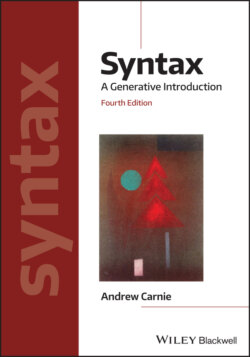Читать книгу Syntax - Andrew Carnie - Страница 12
0. PRELIMINARIES
ОглавлениеAlthough we use it every day, and although we all have strong opinions about its proper form and appropriate use, we rarely stop to think about the wonder of language. So- called language “experts” tell us about the misuse of hopefully or lecture us about the origins of the word boondoggle, but surprisingly, they never get at the true wonder of language: how it actually works as a complex machine. Think about it for a minute. You are reading this and understanding it, but you have no conscious knowledge of how you are doing it. The study of this mystery is the science of linguistics. This book is about one aspect of how language works: how sentences are structured, or the study of syntax and the people who study syntax are called syntacticians.
There are many perspectives on studying linguistics. One could study language looking at languages across time, or one could study how language is used as a social too. But syntacticians typically take a different view. They look at language as a psychological or cognitive property of humans. That is, my mind contains certain principles that allow me to sit here and produce this set of letters, words and sentences, and you use similar principles that allow you to translate these squiggles back into coherent ideas and thoughts. At least I hope you can translate them back into coherent ideas!
There are several subsystems at work in when we use language. If you were listening to me speak, I would be producing sound waves with my vocal cords and articulating particular speech sounds with my tongue, lips, and vocal cords. On the other end of things, you’d be hearing those sound waves and translating them into speech sounds using your auditory apparatus. The study of the acoustics and articulation of speech is called phonetics. Once you’ve translated the waves of sound into mental representations of speech sounds, you analyze them into syllables and pattern them appropriately. For example, speakers of English know that the made-up word bluve is a possible word of English, but the word bnuck is not. This is part of the science called phonology. Then you take these groups of sounds and organize them into meaningful units (called morphemes) and words. For example, the word dancer is made up of two meaningful bits: dance and the suffix -er. The study of this level of language is called morphology. Next you organize the words into phrases and sentences. One usage of the term syntax is the cover term for studies at this level of language. Finally, you take the sentences and phrases you hear and translate them into thoughts and ideas. This last step is what we refer to as the semantic level of language.
Syntax as a discipline studies the part of language knowledge that lies between words and the meaning of utterances: sentences. It is the level that mediates between sounds that someone produces (organized into words) and what they intend to say.
Perhaps one of the truly amazing aspects of the study of language is not the origins of the word demerit, or how to properly punctuate a quote inside parentheses, or how kids have, like, destroyed the English language, eh? Instead it’s the question of how we subconsciously get from sounds and words to the meaning of sentences. This is the study of syntax.
